By Megan Stroud | Photography by Alexis Henderson | Logo by Caleb Brackney
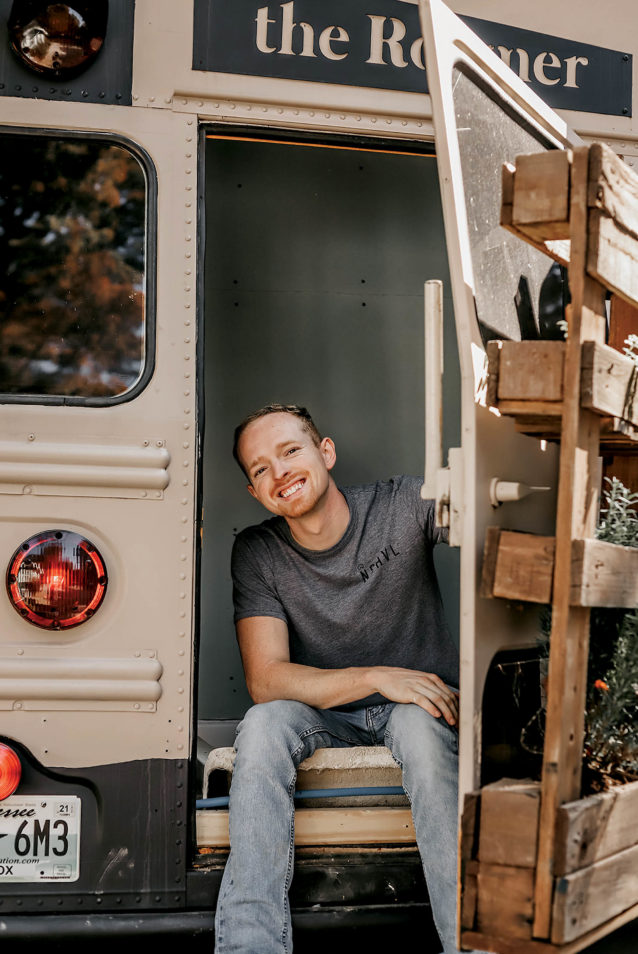
Inspired by what he learned in the interior design program at Harding, Caleb Brackney (’18) converted a school bus into his own tiny home for only $10,000, utilizing space planning and repurposing unusual materials to create a viral result.
Brackney came to Harding to study interior design as preparation for the dual master’s degrees he is currently pursuing at the University of Tennessee — a Master of Architecture and a Master of Landscape Architecture.
“Harding grounded me, taught me fundamental skills and ideas, and introduced me to a lot of concepts that graduate school did not,” Brackney said. “I learned a lot about how space affects lifestyle and how materials and textures influence the way you experience life. They sound simple, but studying them really opens the world up to understanding how all those things come into play to form your experience. Landscape architecture deals with textures and patterns in nature while interior design is on the inside. Those honestly go together more for me than architecture and interior design because architecture is about projects where interior design and landscapes are about people.”
Brackney decided to be a landscape architect when he was 12 years old while riding in his music teacher’s Jeep full of plants. Raised in a family with seven children, playing music together — whether it be a fiddle, mandolin, bass, banjo or guitar — was their way of bonding and spending time together. In the same way that music is woven into Brackney’s decision to become a landscape architect, music also is woven into the space he created for himself in the “Roamer Bus.”
When Brackney decided to go for it, he shopped on Facebook Marketplace for about a month before purchasing a 36-foot, 1995 Thomas International school bus for $3,000. With only $7,000 left in his budget for a project that typically takes nearly $50,000 to complete, Brackney focused on repurposing materials, learning things like plumbing, carpentry and sewage on the go, and personalizing the 220 square feet of space to his own lifestyle using space planning.
“Space planning, for me, is about using spaces for as many different purposes as you can,” Brackney said. “It’s understanding how spaces are used and organizing them in a way to maximize their potential.”
Brackney’s kitchen, which is home to the mini fridge from his college dorm, utilizes the driver’s space for additional storage. His unique skylight allows him to stand up tall in front of his kitchen and closet. His living and bedroom are combined to allow more guests to sit comfortably in front of his swivel television. His bathroom, hidden in the back of the bus behind his headboard, allows the large door in the back of the bus to remain functional for loading and unloading larger items. Other features include a 7-foot closet, queen bed, couch that converts into a second bed, headboard with magnetic cabinet doors, and hammock hooks.
“There is no wrong or right way to do it,” Brackney said. “I think that’s why it’s so critical to understand your client or yourself when you are doing a project like this.”
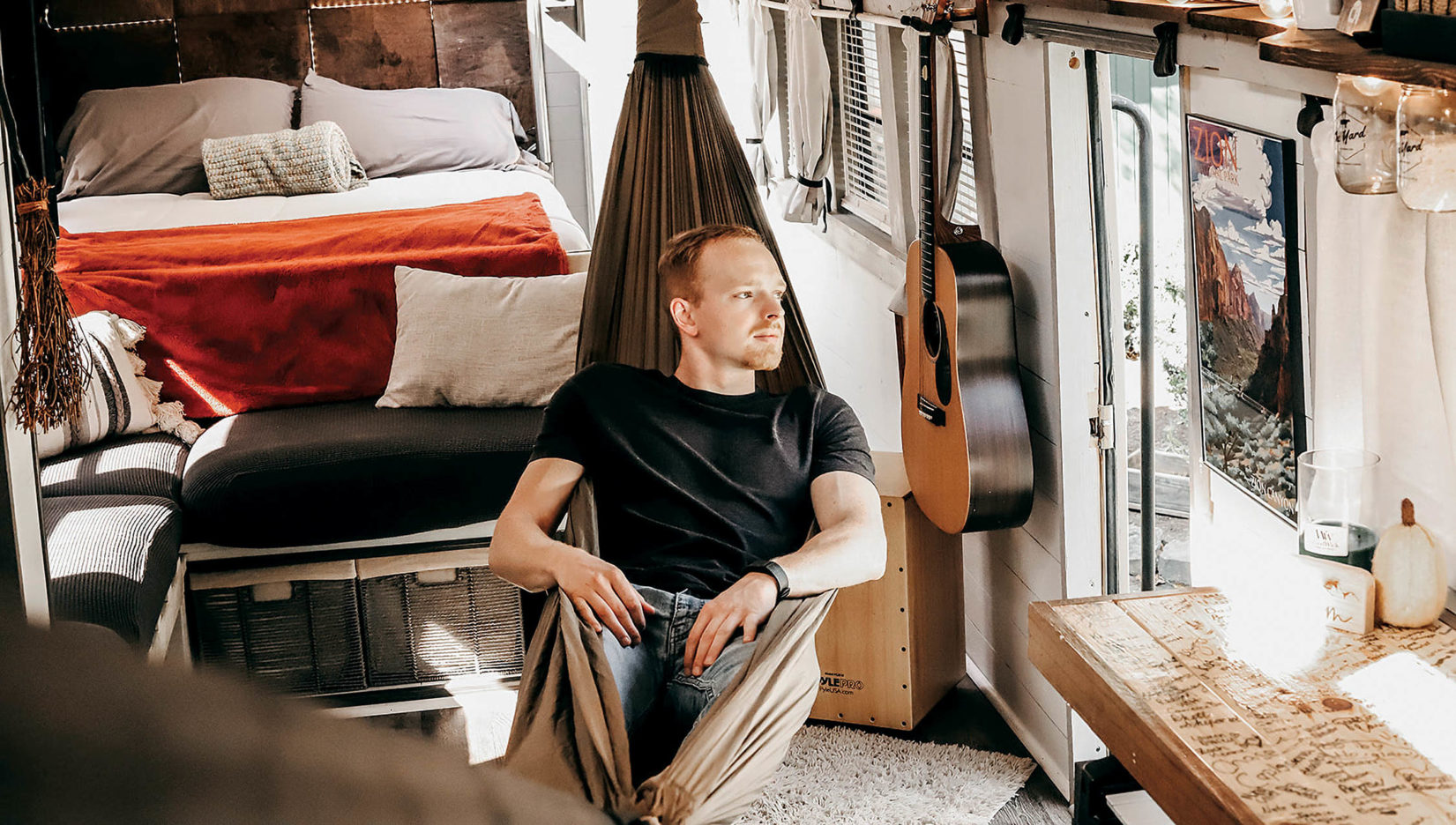
One of Brackney’s favorite aspects of the bus is utilizing optical illusion. The shiplap in the front of the bus is actually wider than the shiplap in the back so that when you are in the front of the bus looking backward, it makes it look longer and wider. He created the same effect with the shelves on the sides, which taper in and become smaller as you move from the kitchen to the bedroom. Brackney used intentional design to make the most out of a small, 7.5-foot-wide space.
“In my head I had this vision for basically what it turned out to be, but I honestly didn’t think it would get so viral,” Brackney said.
Since its completion, the “Roamer Bus” has gained 2.5M views on TikTok and 52,000 followers on Instagram alone. Because he was getting daily inquiries about different aspects of his project, he created a website and Etsy store where people could use his plans and ideas as resources for their own projects.
Brackney lives in the bus full time with his golden doodle Ivy and plans to take it to Berkeley, California, this summer for a highly competitive internship with Peter Walker Landscape Architects, known for projects all over the world such as the 9/11 Memorial, Marina Bay Sands Resort and Jewel Changi Airport.
“Walker is arguably the most famous landscape architect alive,” Brackney said. “One intern is from India, one is from Harvard and one is me, and the reason I got it is because of the bus. They loved the idea of using what knowledge I have learned in school and figuring out how to do something like this. The bus was my way of getting in. I am no different from anyone else at Harding. My dad is a minister, I am the oldest of seven kids, and I was homeschooled. I think it shows that if you work really hard, you can be bold.”
Brackney began this conversion project as a personal case study to apply what he had learned in school and, at the end, gained a full-time home, confidence in his ability and a chance to show off his work to the world. With the “Roamer Bus,” he has no roots and no limits, and he encourages others to do the same by finding their passion and sharing it with the world.
“Focus on what is interesting to you in your field. You chose interior design for a reason — or business students choose business for a reason, or PT students choose that for a reason. Focus on what excites you about your passion. Your passion is not necessarily just your major. There are so many different aspects of it. If you focus on what inspires you, figure out a way to show that to the world. When you have an idea that you are really passionate about, start acting. I am so thankful I acted and accomplished this dream. If you are passionate about something, don’t let other people hold you back from what you want to do, but build off their excitement as it progresses. At the end of this conversion, so many people were excited about it, and it kept me inspired. I led the charge for inspiration and then relied on other people the rest of the way.”

Learn more about Caleb Brackney and the Roamer Bus by following him on Instagram and Tiktok (@RoamerBus ) and exploring his website ( roameroutpost.com ) where you can watch his Tiny Home Tour .
Caleb Brackney made a small space a functional home in which he can thrive. Learn more about some of his favorite innovative ideas utilizing space planning and repurposed items on a budget.
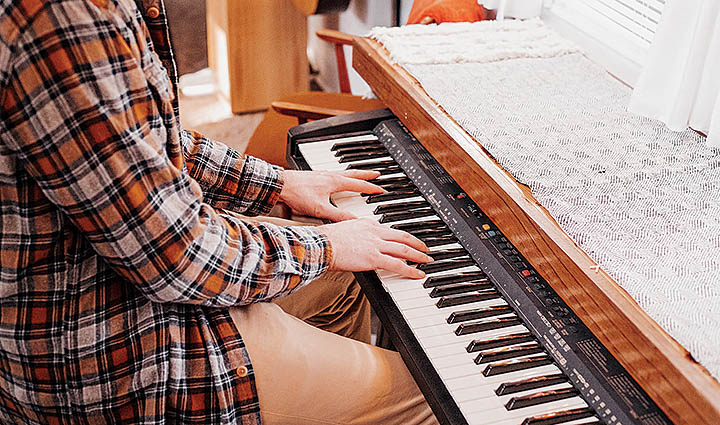
If music is what makes your space feel like home, utilize space to hide it away when it’s not being used. A slide-out keyboard from the main eating and studying space offers a perfect opportunity to hide a piano. “Music is special to me, so I intertwined it with my bus because it’s my life and home,” Brackney said. “ I’m not the most accomplished musician, but I enjoy playing with other people and building memories around a campfire with a guitar.” Brackney also was a member of Belles & Beaux while he was a student at Harding.
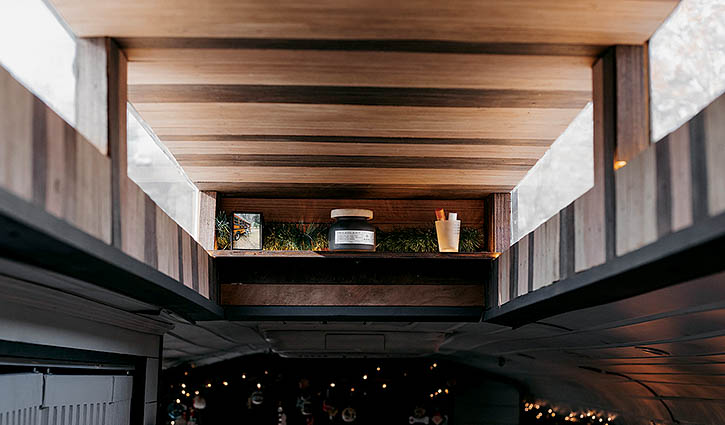
If you are too tall to stand up straight inside a bus, like Brackney, find a way to create more head-room. Acrylic strips let light stream in and fill the center of the bus while adding extra headspace. “I have never seen anyone do skylights like this,” Brackney said. “I got the idea from researching sailboats, which have closed, rounded interiors. Some sailboats have a little bit of a skylight above, so I just cut a hole in the ceiling, hoped the bus didn’t fall apart and made it work. It makes a big difference.”
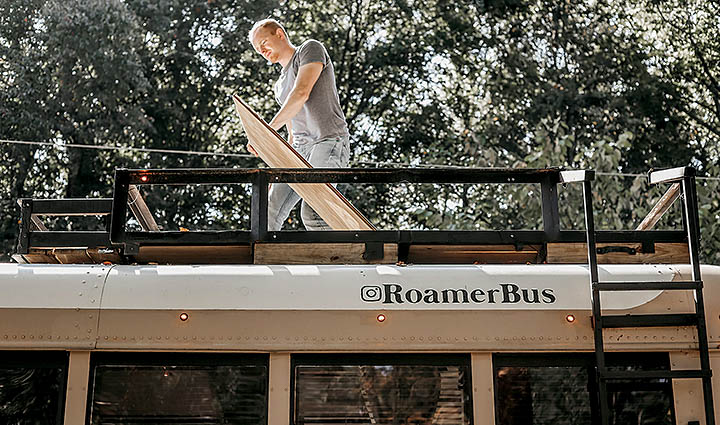
Even with a small interior space, the bus serves as a camping destination for many of his friends, so Brackney created an outdoor space on the top of the bus. After taking the axle off an old trailer, he attached it to the two rails on the roof, preventing leaking that would have occurred from bolting into the sheet metal.
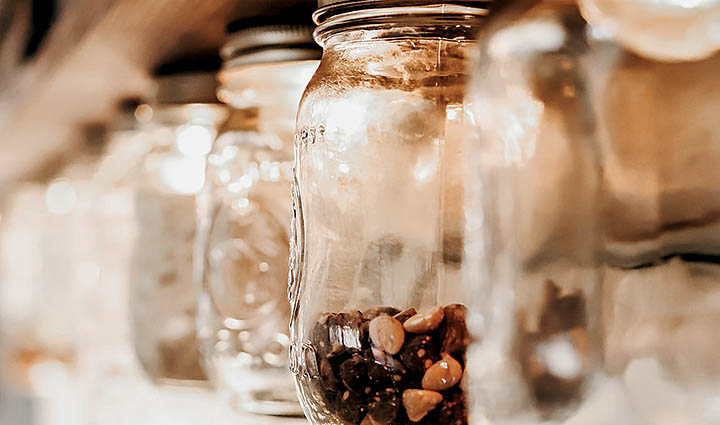
In search of extra light and storage, Brackney used a set of mason jars, half of which serve as storage containers while the other half serve as drinking cups and clear shades on light bulbs. He is an advocate of glass storage, and attaching the tops of mason jars into the shelf makes it a rattle-proof and shatter-proof option on the road. “I had seen the idea about mason jars hanging, but dropping the lights in was one of my little brother’s ideas,” Brackney said. “I needed some light on my desk area, but I didn’t want lamps sitting on the counters. It’s so iconic. I’ve never seen anyone do this before, and it ties in with the lights in the back, which was actually a repurposed light fixture from the Branding Project during my junior year at Harding.”
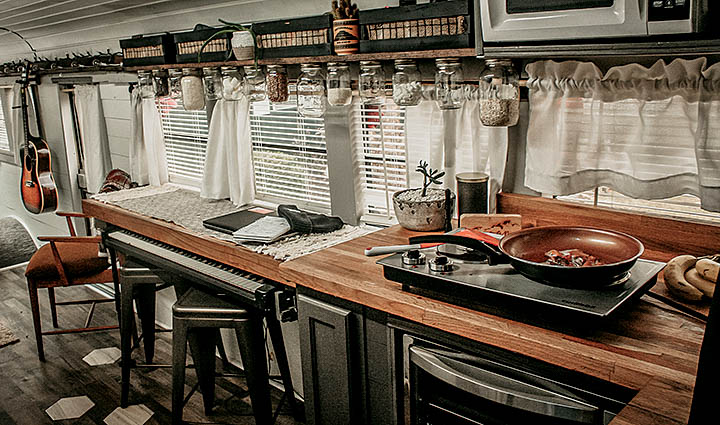
Countertops are essential but costly. Brackney found these old semi-truck beds made of oak on Facebook Marketplace for only $40. Knowing it would be durable, he bought them and repurposed them into his butcher block kitchen countertops by planing, sanding and staining them.
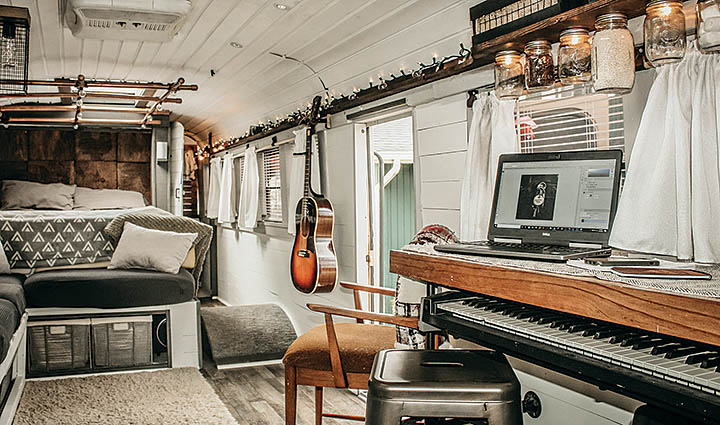
Create an illusion of more space with intentional design. Much like the windows of Cinderella’s castle get smaller as they go up to create the illusion of a taller building, the shiplap in the front of the Roamer Bus is actually wider than the shiplap in the back so that it looks longer and wider when looking from the front of the bus to the back. Brackney created the same effect with the shelves on the side of the bus, which taper in and become smaller moving from the kitchen in the front to the bedroom in the back. By utilizing intentional design, he was able to make the most out of a narrow space.
Architecture coming Fall 2022
The 168-hour accelerated program, built on a cohort model, will result in the completion of a Bachelor of Arts in architectural studies and a Master of Architecture in five years. Upon completion of the M.Arch., students will be eligible to sit for the licensure exam. Taught from a Christian perspective and with an emphasis on a liberal arts foundation, the curriculum will support and encourage interactive learning during lectures and studios. Additionally, there are plans to include an internship experience and an international program component to the degree, exposing students to a diverse set of architectural examples around the world. Learn more at harding.edu/architecture .